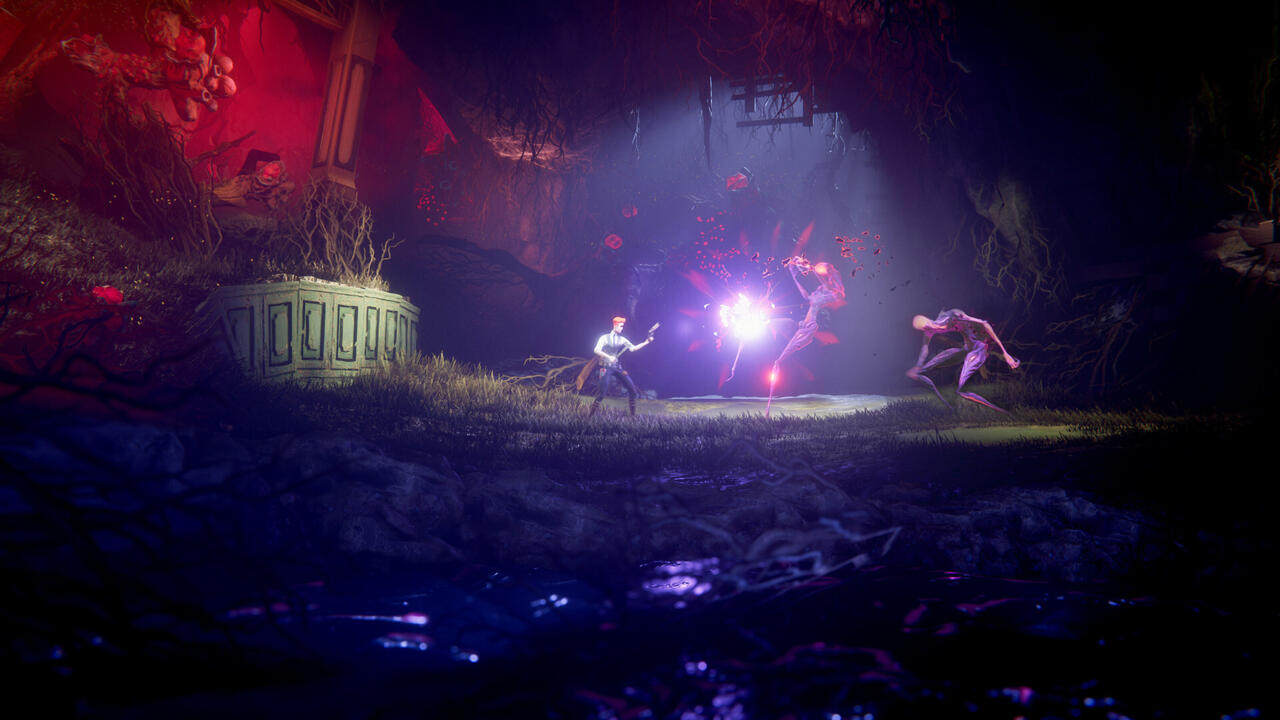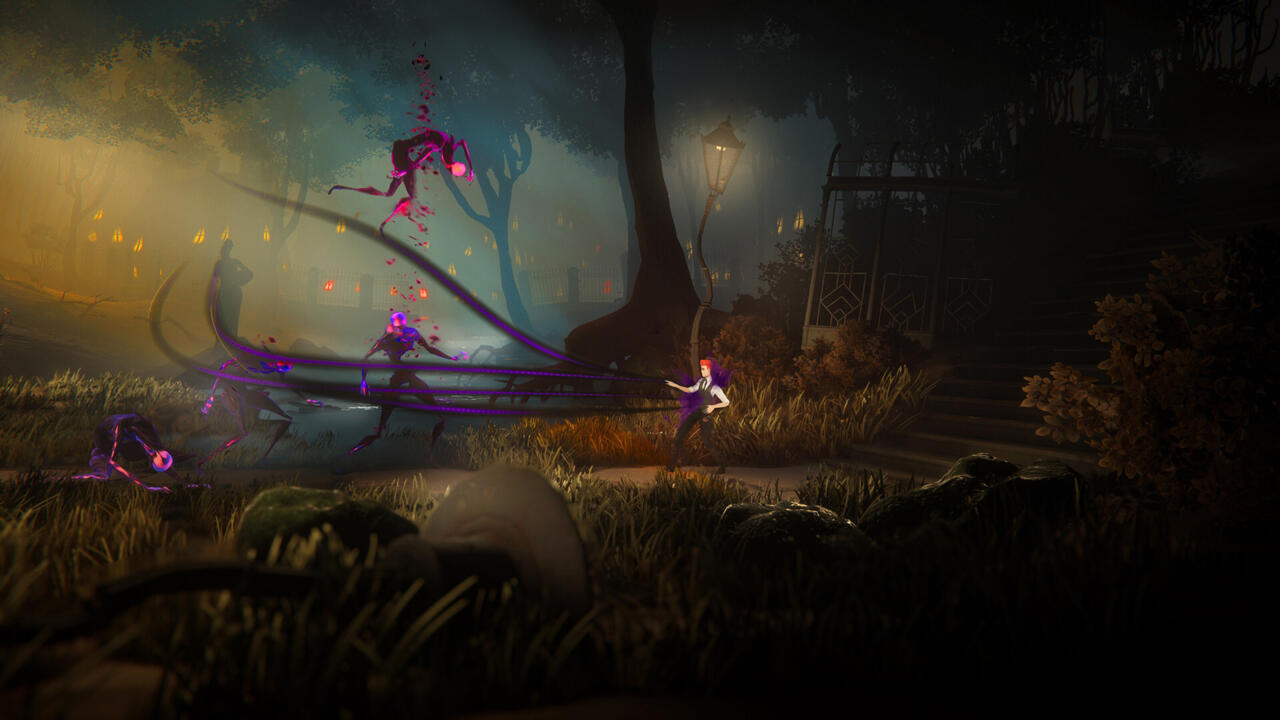Like my favorite metroidvania games, The Last Case of Benedict Fox is built around solving a mystery. It can go too far in its efforts to be deeply mysterious, especially in its first half, but engaging puzzles and unsettling art direction pull you along, even when mediocre combat and platforming mechanics get in the way of the fun. There's an interesting story in The Last Case of Benedict Fox, one wrapped up in an interesting world of supernatural intrigue that I want to know more about. It just takes a while to fully uncover its best parts.
In The Last Case of Benedict Fox, you play as the titular detective, who breaks into a strange manor in order to investigate a ritual he wants to perform. The answers he seeks, unfortunately, reside in the minds of a young couple who are now dead. Thankfully, Benedict is connected to an eldritch-like demon who grants him supernatural powers, including the ability to go into the minds of those freshly dead. Going into Limbo--as Benedict calls it--transports you into a space of sprawling mind palaces, each filled with the deceased's worst nightmares, insecurities, and traumas transformed into physical monsters. As you explore further and farther, you find the necessary memories to unlock new parts of the manor in the real world and piece together the steps to the ritual.
If all of that sounds a little convoluted and leaves you with many questions, that seems to be what The Last Case of Benedict Fox is going for, simply dropping you into a densely layered situation without the necessary build-up to fully grasp what's going on. The game holds its cards too close to the chest, unfortunately--going so far as to hide for the entire first half of the game what exactly the ritual that Benedict is researching even does and why he's looking for it. The plot swings way too far past intriguing and mysterious into confusing territory for the first half of its runtime. This makes for a deeply unwelcoming opening, which sets up a story and character motivations that are difficult to parse, with names, dates, lore, and jargon quickly thrown at you with little in the way of explanation. Once you manage to get a ways into the game, The Last Case of Benedict Fox graciously begins answering a few of the questions it poses, giving you more of a reason for wanting to explore its riveting Lovecraftian-inspired world, but it still just takes way too long to get there.

Which is a shame because, as it turns out, The Last Case of Benedict Fox happens to be built upon a fascinating world and deep lore that's begging to be uncovered, a winning recipe for a metroidvania game given the genre's traditional focus on exploration. Once you're incentivized to go out and map the hallways of people's dying psyches there are a lot of cool supernatural threads to pull on, all styled in a world that feels somehow disturbingly colorful for how heavy its narrative gets. Each part of Limbo is more horrifyingly beautiful than the last. I especially enjoyed how the minds of the people you're jumping into inform each level's unique layout and environmental puzzles. One moment may find you running through a maze composed within the logic of a scientist, for example, the rhythmic clockwork of his dying mind transforming the space with a regular rhythm. And then the next, you're diving into the mind of a woman who died at the end of her emotional rope, with pools of poison, ichor-lined walls, and a frigid underbelly all that remains of her emotionally damaged core.
Exploring these spaces is key to solving The Last Case of Benedict Fox's many environmental puzzles, which is the primary means of progression in the game. Early on, you discover that Benedict needs to find three pages, each detailing a step in the ritual needed to separate him from his companion. The pages are scattered about the manor, requiring a bit of sleuthing on your part, since whoever designed Resident Evil 2's Raccoon City Police Station clearly was also the architect of this manor--it is filled with an assortment of locks, each hiding secrets that allow you to further explore the manor or uncover more of the story.
The keys you need lie in the memories of those who once lived in the manor, meaning you're regularly diving into the dying minds of those who once lived there to uncover their secrets. Is there a paper with notes on it that you need, but it's burned beyond recognition in the real world? Go into the mind of the person who saw it last, and explore the part of his brain that represents his suppressed guilt and anger of that moment. Does a locked door require three oddly specific keys to open? Better dive into the mind of the dead body nearby to see if he has a recollection of that key that you can bring back with you into the real world.
A wider variety of puzzles exist within the Limbo worlds, too. I've found doors that required me to play a chess match in a certain way to get through them, and combination locks where I had to take a picture of the clues with my phone in order to refer back to them while inputting the answer. The Last Case of Benedict Fox is no pushover when it comes to flexing your brain, but it never quite reaches a degree of difficulty so off-putting that the brain twisters ever get irritating.

In true metroidvania fashion, there are also locks tied to abilities. These come in two forms. There are some obstacles in the world--numeric locks and walls of miasma--that can only be surpassed by unlocking upgrades to Benedict's equipment, requiring you to find specific items in Limbo. Additionally, there are locks in Limbo--like breakable floors and demon-coated doorways--that only your demon companion can overcome, requiring you to get tattoos made from the inky blood carved out from enemies. With these parallel paths, you're regularly rewarded, whether it's for finding new areas and discovering equipment upgrades or overcoming enemies and collecting enough ink for a new tattoo. That said, for as enjoyable as it is to explore Limbo and uncover the secrets hidden away in people's minds, combat falls short.
The Last Case of Benedict Fox is routinely dragged down by clunky and unrewarding combat mechanics. Benedict is designed as a careful fighter--his repertoire in combat consists of a simple counter, slow melee strikes, a flintlock-like flare gun, and a meanderingly slow healing mechanic. These mechanics don't match the pace of the enemies that Benedict is going up against, as most foes are quite nimble and hit hard and fast, meaning you'll often find yourself quickly overwhelmed when attacked by more than one enemy. It makes for a frustrating loop in which you're routinely punished for Benedict not being able to react to an enemy's attacks anywhere near fast enough and have to just keep repeatedly banging your head against the same challenge until you're lucky enough to get past it.
The platforming gauntlets are also quite the momentum-killers. At certain points in the game, Benedict will be locked into a chase where failing to escape his pursuer is instant death, sending you back to the start of the run. It doesn't matter if you died right at the start or near the end; failing to perfectly execute every jump during these sequences sends you back to square one--in some cases, that's nearly a minute of tense platforming. These sequences wouldn't be too irritating in an actual platformer, but The Last Case of Benedict falters in how poorly its jump mechanic fits platforming challenges.
And that's a shame, because here's the thing: I actually like how platforming works in the game--Benedict's demon companion uses its shadowy tentacles to latch onto nearby platforms and pull Benedict forward with a slow momentum. It's visually creepy and narratively cohesive, explaining how an otherwise normal man can double jump. But the floaty and imprecise nature of these jumps does not match the necessary speed and precision for a platforming chase sequence--much like the combat mechanics, there's an irritating disconnect between what the mechanics are and what the game is tasking you to do.

In response to its shortcomings, The Last Case of Benedict Fox has several excellent approachability settings, allowing you to customize the degree of difficulty for combat, puzzles, and exploration. You can make combat much harder, where enemies take quite a few hits to go down, for example, or go the opposite and decrease the challenge so every enemy (even some bosses!) is defeated in one or two strikes. There's even an invincibility mode, which, when combined with the easier combat setting, essentially removes combat from the game entirely. When I tried playing the game in this way--while also upping the challenge of puzzles and exploration so that I really had to scour every nook and cranny to find the clues I needed--I actually started enjoying the game a lot more.
On their own, these approachability systems are great for making The Last Case of Benedict Fox more welcoming to folks who are struggling with any one of the three core gameplay pillars, but they also clearly highlight that combat is holding this game back. When you only have to worry about the puzzles and exploration side of the game, it streamlines the entire experience and makes it easier to appreciate the attention to detail when it comes to the story and art direction.
The Last Case of Benedict Fox is one of my favorite flavors of metroidvania: the kind that keeps you guessing all the way up to the end on what's exactly going on. In the first half of the game, it goes too far in terms of setting up its mystery but the narrative payoff in the latter half partially makes up for it. This is the type of game where having a trusty notebook on hand is a good idea because the world design and cryptic story--though wonderful--aren't going to do much to guide you beyond hinting at a potential path forward. The combat and platforming don't quite match the game's intriguing story and wonderful Lovecraftian-inspired art direction, but the game does include ways for you to transform the experience of playing the game to make it more approachable.